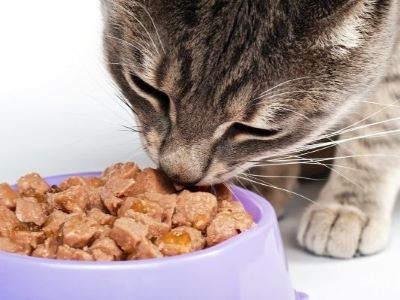You may want to pay attention to your cat’s thyroid health if it is older than 8 years. Many senior cats suffer from the condition hyperthyroidism, which is prevalent and has devastating effects if untreated.
In this blog post, we’ll define hyperthyroidism and go through its causes, symptoms, methods of diagnosis, and available treatments.
What is Hyperthyroidism?
When the thyroid gland overproduces the thyroid hormone thyroxine or T4, a condition known as hyperthyroidism develops. The thyroid gland is a tiny organ in the neck that controls a variety of bodily processes, including growth, metabolism, temperature regulation, blood pressure, heart rate, and nervous system activity.

The body goes into overdrive when there is an excess of thyroid hormones because they have an impact on practically every organ. As a result, there are numerous indications and symptoms that may appear gradually at first but worsen as the condition develops.
Some possible environmental or dietary factors that may increase the risk of hyperthyroidism in cats include:
- Exposure to flame-retardant chemicals (PBDEs) that are used in some furniture and carpeting and circulated in house dust
- Consumption of some fish-flavored canned food diets that may contain high levels of iodine or other substances that affect thyroid function
- Advancing age, as hyperthyroidism is more common in cats older than 8 years
There is no known genetic predisposition for hyperthyroidism in cats, but it is quite common in the cat population. It affects both male and female cats of any breed or background.
What are the Symptoms of Hyperthyroidism in Cats?
Depending on the degree and length of the condition, cats with hyperthyroidism might experience a wide range of symptoms. Among the most typical signs are:

- Despite having more appetite, losing weight
- increased urination and thirst
- diarrhea and vomiting
- Hyperactivity and restlessness
- Aggressive behavior
- untidy or oily coat
- irregular or fast heartbeat
- an enlarged heart or a heart murmur
- breathing challenges or panting
- A lumpy thyroid gland that has grown in size on the neck
enlarged nails
Dr. Audrey Cook, associate professor at Texas A&M College said “A drop in body weight is often the first clue that a cat is suffering from hyperthyroidism, which is one of the reasons why regular vet visits are so important in older cats.”
Unusual symptoms of hyperthyroidism in cats can be, loss of appetite, sadness, and frailty. These less frequent symptoms could point to other underlying health issues.
How is Hyperthyroidism Diagnosed?
If you notice any of the symptoms mentioned above in your cat, you should take them to your veterinarian as soon as possible. Your veterinarian will perform a physical examination and palpate your cat’s neck area to check for an enlarged thyroid gland.
They will also check your cat’s heart rate, blood pressure, and body condition.

The level of thyroid hormone (T4) in your cat’s blood must be determined by your veterinarian in order to confirm the diagnosis of hyperthyroidism. T4 levels are often increased in hyperthyroid cats, while some may have normal or borderline levels.
In such circumstances, your veterinarian may need to carry out additional tests, such as monitoring other thyroid hormones (T3 or free T4), carrying out a thyroid scan (a nuclear medicine test that reveals the thyroid’s level of activity), or obtaining a thyroid gland biopsy.
In order to assess your cat’s general health and look for any secondary hyperthyroidism-related issues, your veterinarian may also suggest additional testing. These examinations could involve
- A blood chemistry panel and urinalysis to assess your cat’s kidney function, liver function, electrolyte balance, blood sugar level, and other parameters
- A complete blood count (CBC) to check for anemia or infection
- A chest X-ray or an echocardiogram (an ultrasound of the heart) to check for heart disease or lung problems
What are the Treatment Options for Hyperthyroidism in Cats?
Cats with hyperthyroidism can be treated in four ways: with medication, radioactive iodine therapy, surgery, and dietary therapy. Each solution offers benefits and drawbacks, and the ideal option for your cat will depend on their particular circumstances, your tastes, and your budget.

Your veterinarian will walk you through the benefits and drawbacks of each choice and assist you in making an educated choice.
Medication
The most popular and cost-effective method of treating hyperthyroidism in cats is medication. There are various medications that can reduce the body’s production or impact of thyroid hormones.

The most frequently prescribed medication is methimazole, which comes in pill, liquid, and topical gel forms. Other medications include Felimazole, a coated pill that may be simpler to administer, and Carbimazole, a substance that the body converts to Methimazole.
The low cost, wide availability, and ease of adjustment of medication are its benefits. Its limitations include the fact that it just manages the symptoms of the illness rather than curing it and the need for ongoing administration.
Additionally, adverse reactions from medicine, such as nausea, vomiting, lack of appetite, itching, or blood abnormalities, may occur in certain cats. By changing the dosage or using a different medication, these adverse effects can be minimized.
To make sure the medication is functioning effectively and safely, your doctor will need to routinely check your cat’s blood levels of T4 and other criteria.
Radioactive Iodine Therapy
Radioactive iodine therapy is considered the gold standard treatment for hyperthyroidism in cats. It involves injecting a small amount of radioactive iodine (I-131) into your cat’s bloodstream.
The radioactive iodine travels to the thyroid gland and selectively destroys the abnormal thyroid cells that are producing too much hormone, while sparing the normal cells. The radioactive iodine is then excreted from the body through urine and feces.

Radioactive iodine therapy has the benefits of being extremely efficient, secure, and curative. It doesn’t involve surgery or anesthesia, and it doesn’t harm any other organs or tissues either.
The drawbacks are that it is pricy, need for specialist equipment and personnel, and might not be accessible everywhere.
After the treatment, your cat will also need to remain in a specialized isolation area for a few days to a few weeks until their radiation level returns to a safe level. You won’t be able to see your cat or speak to her during this period.
Surgery
Surgery is another treatment option for hyperthyroidism in cats. It involves removing one or both of the thyroid glands under general anesthesia. The surgery can be performed as an open procedure or as a minimally invasive procedure using an endoscope[1] (a thin tube with a camera and instruments attached).

The benefits of surgery include the ability to typically cure diseases and the lack of need for radiation or lifelong medication.
The drawbacks include the necessity of surgery and anesthesia, which come with certain dangers and problems include bleeding, infection, nerve injury, and low blood calcium levels (hypocalcemia).
Additionally, cats with heart disease or other medical issues may not be candidates for surgery. Before the procedure, your veterinarian will need to do a few tests to make sure your cat is a good candidate.
Dietary Therapy
Dietary therapy is a newer treatment option for hyperthyroidism in cats. It involves feeding your cat a special prescription diet that is low in iodine, which is an essential component of thyroid hormones.
By limiting the amount of iodine in your cat’s diet, you can reduce the amount of thyroid hormone they produce.

Dietary therapy has the advantages of being easy, secure, and non-invasive. It does not have any side effects or complications and does not call for medication or surgery.
The drawbacks include the possibility that not all cats will benefit from medication, especially those with severe hyperthyroidism or other medical issues.
Additionally, stringent diet adherence is necessary, as are no other foods or treats. To verify that the diet is working properly and safely, your veterinarian will need to routinely check your cat’s blood levels of T4 and other criteria.
FAQs
Can hyperthyroidism in cats be cured?
Radioactive iodine therapy or surgery, which can remove or eliminate the aberrant thyroid tissue, are two treatments for hyperthyroidism in cats. However, not all cats should choose these options because they include certain potential risks and difficulties. Although hyperthyroidism cannot be cured, medication and dietary therapy can manage its symptoms.
How can I prevent hyperthyroidism in my cat?
Since the precise source of the condition is unknown, there is no surefire treatment to prevent hyperthyroidism in your cat. However, you may lessen the risk of hyperthyroidism by keeping your home free of flame-retardant chemicals (PBDEs), feeding your cat a nutritious diet low in iodine, and keeping a close eye on your cat’s weight and health.
How does hyperthyroidism affect my cat’s heart?
Your cat may experience hyperthyroidism, which can result in heart disease or failure by raising blood pressure and heart rate.
A “gallop rhythm” or heart murmur, which is an irregular heartbeat and the sound of turbulent blood flow in the heart, can also be brought on by hyperthyroidism.
You need to take your cat to the vet right away if they have hyperthyroidism and exhibit heart-related symptoms like wheezing, coughing, or fainting.
How does hyperthyroidism affect my cat’s kidneys?
Your cat’s kidneys may be impacted by hyperthyroidism in two ways. First, hyperthyroidism can increase blood flow and renal filtration rate, which might hide or exacerbate the symptoms of kidney illness.
Second, your cat’s kidneys may become damaged by electrolyte imbalance and dehydration brought on by hyperthyroidism. Therefore, it’s crucial to assess your cat’s kidney health both before and after hyperthyroidism treatment.
Conclusion
In older cats, hyperthyroidism is a frequent condition that, if addressed, can have negative effects. Take your cat to the clinic as soon as you can if you observe any hyperthyroidism symptoms in them, such as weight loss, increased appetite, or hyperactivity.
The optimum course of treatment for your cat’s hyperthyroidism will be suggested by your veterinarian once a few tests are conducted to make the diagnosis.
Medication, radioactive iodine therapy, surgery, or dietary therapy are among options for treating hyperthyroidism. The ideal alternative for your cat will depend on their particular situation, your tastes, and your money. Each option has advantages and disadvantages.
The majority of cats with hyperthyroidism can live long, fulfilling lives with the right care and medication.
References:
- Endoscopy » Small Animal Hospital » College of Veterinary Medicine » University of Florida. (n.d.).

Brenda Castillo is a volunteer groomer of a local pet welfare group in New York and a regular contributor to CatLikesBest. She likes to read & write about cat grooming. She also guardians two chubby tabbies, Belly & Puma.

